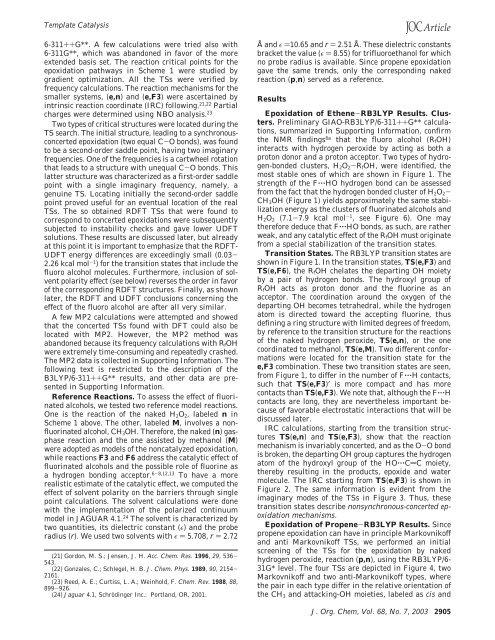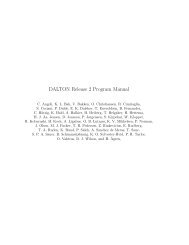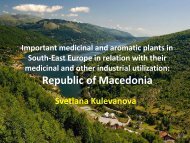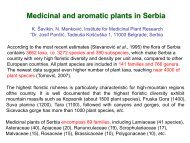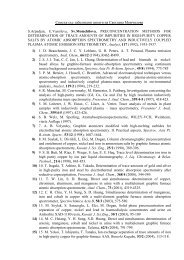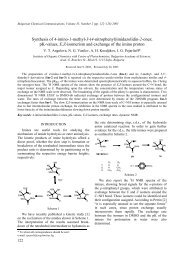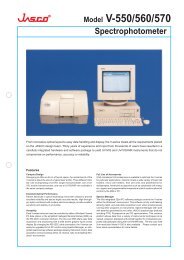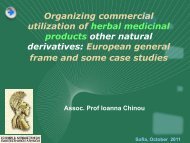Fluorinated Alcohols Enable Olefin Epoxidation by ... - ResearchGate
Fluorinated Alcohols Enable Olefin Epoxidation by ... - ResearchGate
Fluorinated Alcohols Enable Olefin Epoxidation by ... - ResearchGate
Create successful ePaper yourself
Turn your PDF publications into a flip-book with our unique Google optimized e-Paper software.
Template Catalysis<br />
6-311++G**. A few calculations were tried also with<br />
6-311G**, which was abandoned in favor of the more<br />
extended basis set. The reaction critical points for the<br />
epoxidation pathways in Scheme 1 were studied <strong>by</strong><br />
gradient optimization. All the TSs were verified <strong>by</strong><br />
frequency calculations. The reaction mechanisms for the<br />
smaller systems, (e,n) and (e,F3) were ascertained <strong>by</strong><br />
intrinsic reaction coordinate (IRC) following. 21,22 Partial<br />
charges were determined using NBO analysis. 23<br />
Two types of critical structures were located during the<br />
TS search. The initial structure, leading to a synchronousconcerted<br />
epoxidation (two equal C-O bonds), was found<br />
to be a second-order saddle point, having two imaginary<br />
frequencies. One of the frequencies is a cartwheel rotation<br />
that leads to a structure with unequal C-O bonds. This<br />
latter structure was characterized as a first-order saddle<br />
point with a single imaginary frequency, namely, a<br />
genuine TS. Locating initially the second-order saddle<br />
point proved useful for an eventual location of the real<br />
TSs. The so obtained RDFT TSs that were found to<br />
correspond to concerted epoxidations were subsequently<br />
subjected to instability checks and gave lower UDFT<br />
solutions. These results are discussed later, but already<br />
at this point it is important to emphasize that the RDFT-<br />
UDFT energy differences are exceedingly small (0.03-<br />
2.26 kcal mol -1 ) for the transition states that include the<br />
fluoro alcohol molecules. Furthermore, inclusion of solvent<br />
polarity effect (see below) reverses the order in favor<br />
of the corresponding RDFT structures. Finally, as shown<br />
later, the RDFT and UDFT conclusions concerning the<br />
effect of the fluoro alcohol are after all very similar.<br />
A few MP2 calculations were attempted and showed<br />
that the concerted TSs found with DFT could also be<br />
located with MP2. However, the MP2 method was<br />
abandoned because its frequency calculations with R f OH<br />
were extremely time-consuming and repeatedly crashed.<br />
The MP2 data is collected in Supporting Information. The<br />
following text is restricted to the description of the<br />
B3LYP/6-311++G** results, and other data are presented<br />
in Supporting Information.<br />
Reference Reactions. To assess the effect of fluorinated<br />
alcohols, we tested two reference model reactions.<br />
One is the reaction of the naked H 2 O 2 , labeled n in<br />
Scheme 1 above. The other, labeled M, involves a nonfluorinated<br />
alcohol, CH 3 OH. Therefore, the naked (n) gasphase<br />
reaction and the one assisted <strong>by</strong> methanol (M)<br />
were adopted as models of the noncatalyzed epoxidation,<br />
while reactions F3 and F6 address the catalytic effect of<br />
fluorinated alcohols and the possible role of fluorine as<br />
a hydrogen bonding acceptor. 6-8,12,13 To have a more<br />
realistic estimate of the catalytic effect, we computed the<br />
effect of solvent polarity on the barriers through single<br />
point calculations. The solvent calculations were done<br />
with the implementation of the polarized continuum<br />
model in JAGUAR 4.1. 24 The solvent is characterized <strong>by</strong><br />
two quantities, its dielectric constant (ɛ) and the probe<br />
radius (r). We used two solvents with ɛ ) 5.708, r ) 2.72<br />
(21) Gordon, M. S.; Jensen, J. H. Acc. Chem. Res. 1996, 29, 536-<br />
543.<br />
(22) Gonzales, C.; Schlegel, H. B. J. Chem. Phys. 1989, 90, 2154-<br />
2161.<br />
(23) Reed, A. E.; Curtiss, L. A.; Weinhold, F. Chem. Rev. 1988, 88,<br />
899-926.<br />
(24) Jaguar 4.1, Schrödinger Inc.: Portland, OR, 2001.<br />
Å and ɛ )10.65 and r ) 2.51 Å. These dielectric constants<br />
bracket the value (ɛ ) 8.55) for trifluoroethanol for which<br />
no probe radius is available. Since propene epoxidation<br />
gave the same trends, only the corresponding naked<br />
reaction (p,n) served as a reference.<br />
Results<br />
<strong>Epoxidation</strong> of Ethene-RB3LYP Results. Clusters.<br />
Preliminary GIAO-RB3LYP/6-311++G** calculations,<br />
summarized in Supporting Information, confirm<br />
the NMR findings 6a that the fluoro alcohol (R f OH)<br />
interacts with hydrogen peroxide <strong>by</strong> acting as both a<br />
proton donor and a proton acceptor. Two types of hydrogen-bonded<br />
clusters, H 2 O 2 -R f OH, were identified, the<br />
most stable ones of which are shown in Figure 1. The<br />
strength of the F‚‚‚HO hydrogen bond can be assessed<br />
from the fact that the hydrogen bonded cluster of H 2 O 2 -<br />
CH 3 OH (Figure 1) yields approximately the same stabilization<br />
energy as the clusters of fluorinated alcohols and<br />
H 2 O 2 (7.1-7.9 kcal mol -1 , see Figure 6). One may<br />
therefore deduce that F‚‚‚HO bonds, as such, are rather<br />
weak, and any catalytic effect of the R f OH must originate<br />
from a special stabilization of the transition states.<br />
Transition States. The RB3LYP transition states are<br />
shown in Figure 1. In the transition states, TS(e,F3) and<br />
TS(e,F6), the R f OH chelates the departing OH moiety<br />
<strong>by</strong> a pair of hydrogen bonds. The hydroxyl group of<br />
R f OH acts as proton donor and the fluorine as an<br />
acceptor. The coordination around the oxygen of the<br />
departing OH becomes tetrahedral, while the hydrogen<br />
atom is directed toward the accepting fluorine, thus<br />
defining a ring structure with limited degrees of freedom,<br />
<strong>by</strong> reference to the transition structure for the reactions<br />
of the naked hydrogen peroxide, TS(e,n), or the one<br />
coordinated to methanol, TS(e,M). Two different conformations<br />
were located for the transition state for the<br />
e,F3 combination. These two transition states are seen,<br />
from Figure 1, to differ in the number of F‚‚‚H contacts,<br />
such that TS(e,F3)′ is more compact and has more<br />
contacts than TS(e,F3). We note that, although the F‚‚‚H<br />
contacts are long, they are nevertheless important because<br />
of favorable electrostatic interactions that will be<br />
discussed later.<br />
IRC calculations, starting from the transition structures<br />
TS(e,n) and TS(e,F3), show that the reaction<br />
mechanism is invariably concerted, and as the O-O bond<br />
is broken, the departing OH group captures the hydrogen<br />
atom of the hydroxyl group of the HO‚‚‚CdC moiety,<br />
there<strong>by</strong> resulting in the products, epoxide and water<br />
molecule. The IRC starting from TS(e,F3) is shown in<br />
Figure 2. The same information is evident from the<br />
imaginary modes of the TSs in Figure 3. Thus, these<br />
transition states describe nonsynchronous-concerted epoxidation<br />
mechanisms.<br />
<strong>Epoxidation</strong> of Propene-RB3LYP Results. Since<br />
propene epoxidation can have in principle Markovnikoff<br />
and anti Markovnikoff TSs, we performed an initial<br />
screening of the TSs for the epoxidation <strong>by</strong> naked<br />
hydrogen peroxide, reaction (p,n), using the RB3LYP/6-<br />
31G* level. The four TSs are depicted in Figure 4, two<br />
Markovnikoff and two anti-Markovnikoff types, where<br />
the pair in each type differ in the relative orientation of<br />
the CH 3 and attacking-OH moieties, labeled as cis and<br />
J. Org. Chem, Vol. 68, No. 7, 2003 2905


